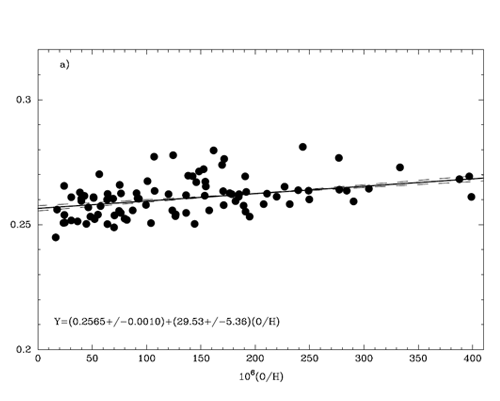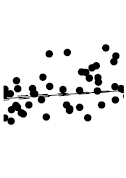We present a new determination of the primordial helium mass fraction Yp, based on 93 spectra of 86 low-metallicity extragalactic HII regions, and taking into account the latest developments concerning systematic effects. These include collisional and fluorescent enhancements of HeI recombination lines, underlying HeI stellar absorption lines, collisional and fluorescent excitation of hydrogen lines and temperature and ionization structure of the HII region. |
 |
Using Monte Carlo methods to solve simultaneously for the above systematic effects, we find the best value to be Yp=0.2565+/-0.0010(stat.)+/-0.0050(syst.). This value is higher at the 2sigma level than the value given by Standard Big Bang Nucleosynthesis (SBBN), implying deviations from it. The effective number of light neutrino species Nnu is equal to 3.68^+0.80_-0.70 (2sigma) and 3.80^+0.80_-0.70 (2sigma) for a neutron lifetime tau(n) equal to 885.4+/-0.9 s and 878.5+/-0.8 s, respectively, i.e. it is larger than the experimental value of 2.993+/-0.011. \\ ( http://arxiv.org/abs/1001.4440 , 103kb)
A New Approach to Systematic Uncertainties and Self-Consistency in
Helium Abundance Determinations
Tests of big bang nucleosynthesis and early universe cosmology require precision measurements for helium abundance determinations. However, efforts to determine the primordial helium abundance via observations of metal poor H II regions have been limited by significant uncertainties. This work builds upon previous work by providing an updated and extended program in evaluating these uncertainties.
Procedural consistency is achieved by integrating the hydrogen based reddening correction with the helium based abundance calculation, i.e., all physical parameters are solved for simultaneously. We include new atomic data for helium recombination and collisional emission based upon recent work by Porter et al. and wavelength dependent corrections to underlying absorption are investigated. The set of physical parameters has been expanded here to include the effects of neutral hydrogen collisional emission. Because of a degeneracy between the solutions for density and temperature, the precision of the helium abundance determinations is limited. Also, at lower temperatures (T \lesssim 13,000 K) the neutral hydrogen fraction is poorly constrained resulting in a larger uncertainty in the helium abundances.
Thus the derived errors on the helium abundances for individual objects are larger than those typical of previous studies. The updated emissivities and neutral hydrogen correction generally raise the abundance. From a regression to zero metallicity, we find Y_p as 0.2561 \pm 0.0108, in broad agreement with the WMAP result. Tests with synthetic data show a potential for distinct improvement, via removal of underlying absorption, using higher resolution spectra. A small bias in the abundance determination can be reduced significantly and the calculated helium abundance error can be reduced by \sim 25%. \\ ( http://arxiv.org/abs/1001.5218 , 606kb) |

![]()
